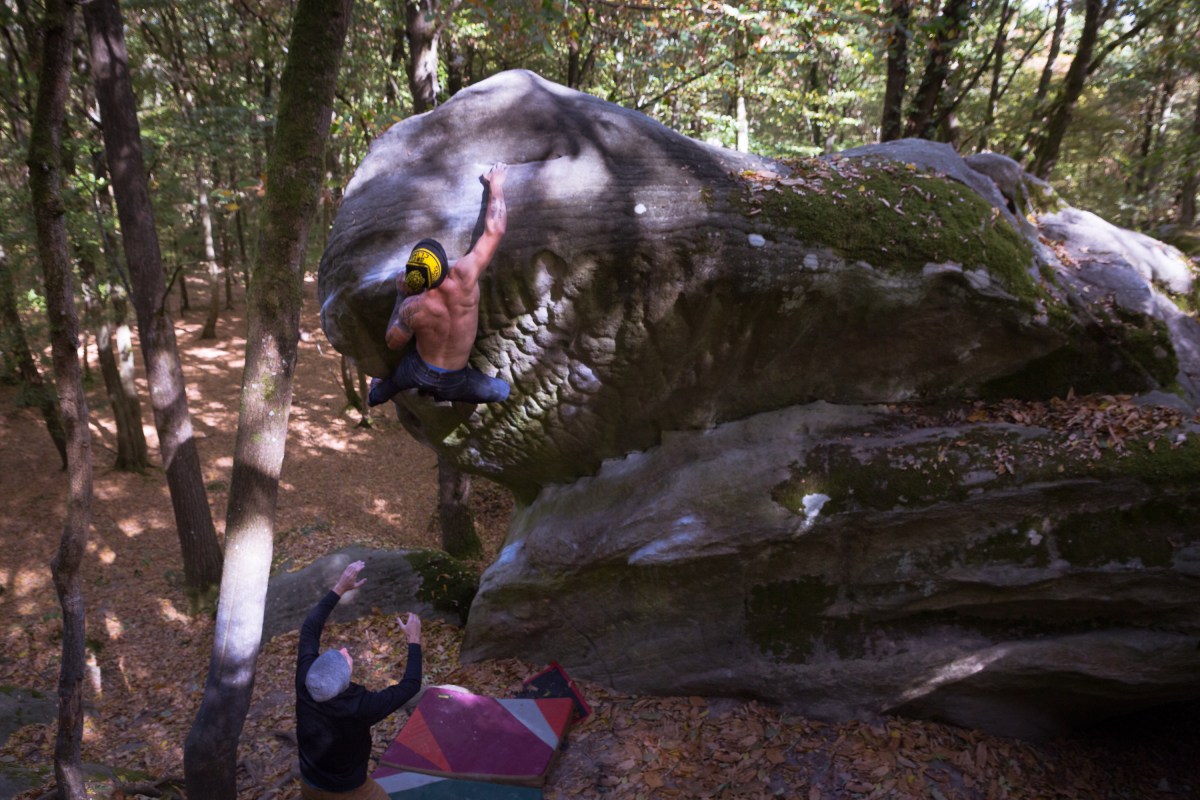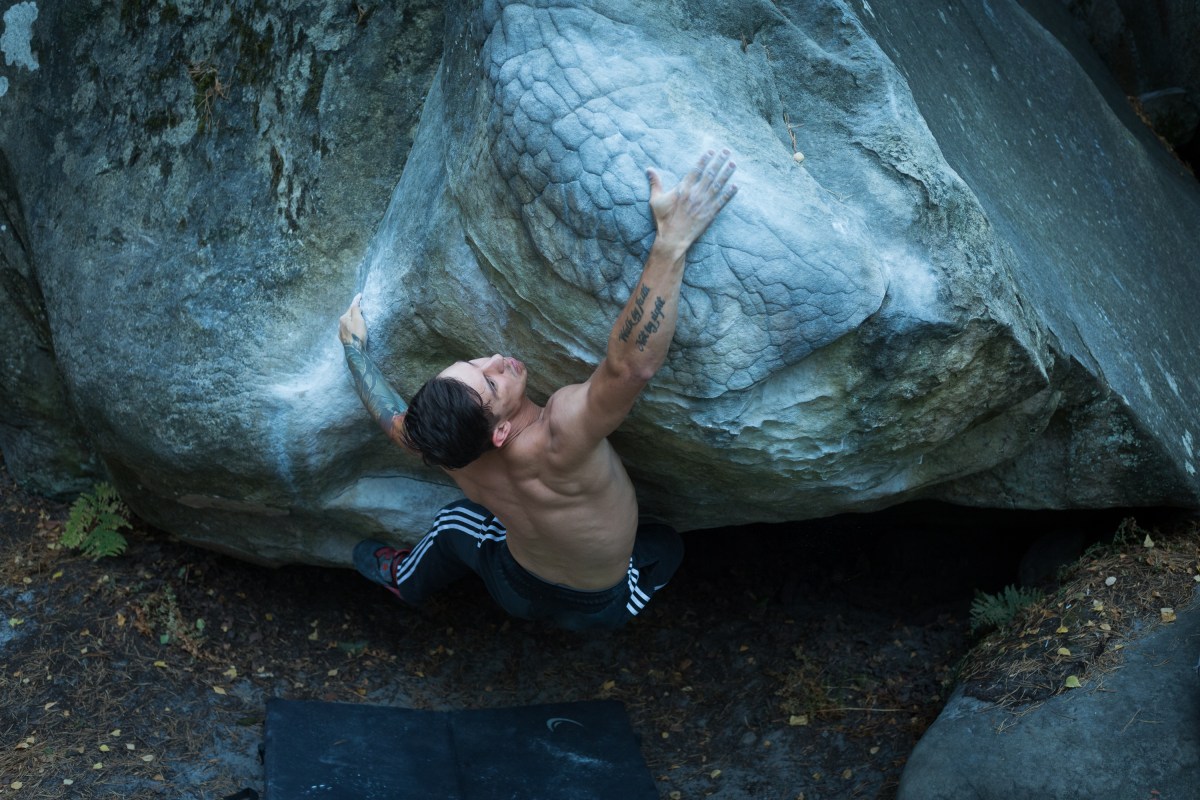Last September, when Justin Salas arrived in Innsbruck, Austria, to compete in the International Federation of Sport Climbing World Championships, he knew there were mountains all around. He just couldn’t see them, at least not directly.
“I can see them in my peripheral vision,” said Salas. “I do this thing, where I look and I scan around, and it’s almost like they’re there. But they’re not. I understand that the mountain range is all around me. But I can’t focus on them. It’s, like, they’re sneaky. They’re in the background.”
Salas is blind. When he was 14 years old, he lost nearly all of his central vision in six or seven months. Doctors diagnosed him with optic neuropathy of unknown origin. Essentially, Salas says his optic nerves were dying. He describes the way he sees as “reverse tunnel vision,” with a dead spot in the center of his visual field. So all he can see is what lies on the fringe. When he looks toward the moon in the night sky, he says he can see a glow, but not the moon itself. “Even in the brightest of full moons,” he says.
But, as Salas proves, you don’t need to see to climb.
The 25-year-old from Tulsa, Oklahoma, took first place in paraclimbing at the IFSC World Championships in Innsbruck this year, which is the world’s most elite sport climbing competition. Last year, he won a silver medal at the International Federation of Sport Climbing Paraclimbing World Cup in Edinburgh, Scotland. He has two gold medal wins at the USA Climbing Adaptive National Championship. And that’s just the part of his resume that’s indoors on artificial terrain. In March 2018, Salas became the first adaptive rock climber to send a V11 boulder problem outdoors.
At Innsbruck, Salas was the last athlete to climb in the finals for the B2 category of visual impairment, which fits under the broader umbrella of paraclimbing. (Paraclimbing is broken into different categories, including arm and leg amputation and visual impairment.) The crowd cheered when he walked into the arena and to the ropes, but as soon as he began to climb, the arena fell silent, which is part of the rules of the competition.
A longtime friend named Matt Frederick stood at the bottom of the route, wearing a headset so he could talk to Salas. Frederick is Salas’ sight guide. He can tell him where the holds are, using cues relative to Salas’ body position: A foot hold at his mid-shin bone, or a hand hold in the two o’clock position.
At Innsbruck, Salas’ long, strong limbs moved quickly and steadily up the first part of the route. He paused only to chalk up. The cameras caught a flash of a tattoo on his right arm that says, “Walk by faith, not by sight.” When he got to the steeper, overhanging section, he placed his hands and feet confidently, but there were one or two times when, for a split second, his hand appeared as if it were searching for a hold. Then, he’d find what he was looking for and shoot upward. The higher he climbed, the more demanding and arm-pumping the moves became.
He breezed past the points where the other competitors had faltered and fallen, not knowing that he had moved into first place. As he reached the crux—an overhanging roof—he shook out his arms. His last move was powerful—a burst of energy to grab a hold just above the roof that tore his feet off the wall. He never flailed—his core strength kept his legs in control. But he couldn’t find the foot hold to bring his toes back to the wall. His hands let go, signaling the end of his climb, and the crowd erupted into cheers.

Justin Salas tops out on a boulder problem called La Baleine. (Photo Credit: Justin Salas)
In Tulsa, Salas grew up next to an airport. “My dream was to be a fighter pilot,” he says. “I would get to see the F16s take off at two—that was when they took off for the afternoon flights.”
As a kid, Salas was active and athletic. He rode a BMX bike around the neighborhood and played soccer. At first, his loss of vision was gradual, and his brain was working overtime to hide it. For example, Salas would run his fingers over the plastic lid of a soda drink to find the hole to put his straw in it—which he says was a subconscious adjustment for not being able to see the hole.“There were all these little things,” says Salas.
On his usual bike route, Salas remembers a big sign for a furniture store. “I saw it everyday,” says Salas. Until one day, when Salas was riding his bike with his friend and looked up at the sign and couldn’t read it anymore.
Then came the doctors’ appointments, and the MRIs, and the news that his optic nerves were dying.
Salas was planning to get his driver’s permit the following year. His parents had bought a car for him and his older brother to share.
“Of course, things changed,” he says. He couldn’t do the tricks he used to on his BMX bike because he couldn’t see where to stand on the bike. Even though he could see people’s feet in his peripheral vision, he couldn’t play soccer because as soon as the ball was kicked into the air, it would disappear.
Mostly, though, Salas adapted. “I was still expected to do school and do my chores.”

Justin Salas won the IFSC World Championships for Paraclimbing this fall. He’s also sending the hardest boulder problems outdoors of any visually impaired climber. (Photo Credit: Justin Salas)
About seven years ago, a friend convinced Salas to go climbing at an indoor gym in Tulsa. He went twice. The friend told him where to place his arms and legs and taught him the basic movements of climbing—how to not get so gripped on the wall, how to hang his arms.
At that time, his family couldn’t afford a climbing gym membership. His father, a lab technician, and his mom, a web developer, were raising five children. They lived in a small house. Before he lost his sight, Salas ran a lawn-care business. It wasn’t until 2015, when he was on Social Security income for having a disability and had rekindled his love for the outdoors through backpacking and camping trips, that he dedicated himself to climbing.
“I found out that, once I memorized a boulder problem, I could climb it by muscle memory,” says Salas. Sometimes, he can find the holds in his peripheral vision, and will snap to them.
He climbed six days a week, top-roping and bouldering in the gym. If he wasn’t climbing, he was lifting weights and training. He worked at the gym, which moved to a new 20,000-square-foot facility, and was setting routes.
“Not only did I fall in love with climbing because I love the movement and the lifestyle and everything about climbing,” says Salas. “I found that I could make a living at it.”
In just two years, Salas became so adept at climbing that he decided to enter his first competition: the Bouldering Adaptive Nationals on February 5, 2017, at The Front Climbing Club in Utah. He took second place in the combined category format. (Ronnie Dickson, an amputee, took first place.)
“I would climb until my hands were bleeding,” he says. “I haven’t found any aspect of climbing where vision is a requirement. Of course, it can make things easier. I’m not the best flash or on-site climber… But I’ve always found my own way of doing things. If a move is dynamic and visually intense, most often, I can find a way.”
Salas is also climbing outdoors, sending boulder problems that are far beyond the gym doors. Worm Turns is a 15-foot V11 boulder problem in Joe’s Valley, Utah, defined by a long tufa ridge that snakes up to the roof. Salas says when he first attempted to climb it in 2016, he thought it was the “coolest thing in the world.” But he couldn’t do the crux move—the part where you “turn the worm” on the boulder. Fast forward to spring break 2018, and Salas sent the problem on his first day back in Utah. The ascent made him the first blind, adaptive climber to send the grade, wrote Rock and Ice magazine.
Looking ahead to 2019, Salas is climbing professionally for Petzl and Evolv. He’s a sponsored athlete for Adidas. He’s also a world champion.
“I’d say climbing literally saved my life,” says Salas. “I just want to continue to push the limits of what’s possible.”
